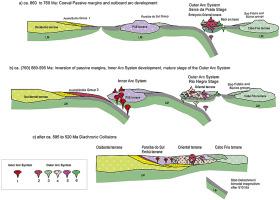当前位置:
X-MOL 学术
›
J. South Am. Earth Sci.
›
论文详情
Our official English website, www.x-mol.net, welcomes your
feedback! (Note: you will need to create a separate account there.)
Neoproterozoic magmatic arc systems of the central Ribeira belt, SE-Brazil, in the context of the West-Gondwana pre-collisional history: A review
Journal of South American Earth Sciences ( IF 1.7 ) Pub Date : 2020-11-01 , DOI: 10.1016/j.jsames.2020.102710 Monica Heilbron , Claudio de Morisson Valeriano , Caroline Peixoto , Miguel Tupinambá , Franz Neubauer , Ivo Dussin , Felipe Corrales , Henrique Bruno , Marcela Lobato , Julio Cesar Horta de Almeida , Luiz Guilherme do Eirado Silva
Journal of South American Earth Sciences ( IF 1.7 ) Pub Date : 2020-11-01 , DOI: 10.1016/j.jsames.2020.102710 Monica Heilbron , Claudio de Morisson Valeriano , Caroline Peixoto , Miguel Tupinambá , Franz Neubauer , Ivo Dussin , Felipe Corrales , Henrique Bruno , Marcela Lobato , Julio Cesar Horta de Almeida , Luiz Guilherme do Eirado Silva

|
Abstract This synthesis presents the complex evolution of two different magmatic arc systems in the Ribeira belt, which were progressively accreted onto the southeastern and southern border of the Sao Francisco paleocontinent. The Inner Magmatic Arc System, developed between ca. 650 and 595 Ma within a Paleoproterozoic microcontinent, is presently represented by the Socorro, Marceleza-Leopoldina and Serra da Bolivia arcs, and possibly by arc-related rocks within the Embu terrane. The Inner Magmatic Arc System collided against the southeastern margin of the Sao Francisco (SFC) paleocontinent at ca. 600 Ma, at about the time of the emplacement of syn-collisional granitoid rocks into the lower plate. Few inherited zircons of Tonian age and one description of a Tonian body related with the Embu Complex could indicate that subduction of the Inner Magmatic Arc System started earlier in the southern Ribeira belt. On the other hand, the Outer Magmatic Arc System comprises the rocks of the Serra da Prata and Rio Negro magmatic arcs. The available geochemical, geochronological and isotopic data of magmatic rocks indicate a two-stage evolution with an intra-oceanic arc setting for the first stage between ca. 860-760, and a Japan-style tectonic setting for the ca. 640-605 Ma s stage. Within both stages, a geochemical polarity that pointed to east-verging subduction has been documented, as well as a lack of older basement rocks in the outer arc domain. During this period of subduction, the Outer Magmatic Arc System produced a considerable volume of Neoproterozoic juvenile addition to the crust. If considered together with other examples of West-Gondwana, the Neoproterozoic magmatic arc development testifies a dynamic scenario until the final docking onto the SFC paleocontinent. Finally, the pre-collisional magmatic evolution envisaged here for the Ribeira belt is very similar in time and composition to that of the Goias Magmatic Arc, in the Brasilia orogenic belt of central Brazil, as first proposed by Marcio Pimentel and co-workers.
中文翻译:

西冈瓦纳前碰撞历史背景下的巴西东南部里贝拉中部新元古代岩浆弧系统:综述
摘要 该综合展示了里贝拉带中两个不同岩浆弧系统的复杂演化,这些岩浆弧系统逐渐增生到圣弗朗西斯科古大陆的东南部和南部边界。内岩浆弧系统,开发于约。650 和 595 Ma 位于古元古代微大陆内,目前以 Socorro、Marcelza-Leopoldina 和 Serra da Bolivia 弧为代表,并且可能以 Embu 地块内的弧相关岩石为代表。内岩浆弧系统在大约 20 年与圣弗朗西斯科 (SFC) 古大陆的东南边缘发生碰撞。600 Ma,大约在同碰撞花岗岩入下板块的时间。很少有托尼安时代的继承锆石和与恩布复合体有关的托尼安天体的一种描述可能表明内岩浆弧系统的俯冲较早在南里贝拉带开始。另一方面,外岩浆弧系统包括 Serra da Prata 和 Rio Negro 岩浆弧的岩石。岩浆岩的可用地球化学、地质年代学和同位素数据表明,在大约 10 至 100 米之间的第一阶段具有洋内弧设置的两阶段演化。860-760,以及约的日本式构造环境。640-605 马的阶段。在这两个阶段中,都记录了指向东向俯冲的地球化学极性,以及外弧区域缺乏较老的基底岩石。在这个俯冲时期,外岩浆弧系统在地壳中产生了大量的新元古代幼体。如果与西冈瓦纳的其他例子一起考虑,新元古代岩浆弧的发展证明了一个动态场景,直到最终与 SFC 古大陆对接。最后,这里设想的里贝拉带的碰撞前岩浆演化在时间和成分上与巴西中部巴西利亚造山带的戈亚斯岩浆弧非常相似,这是由 Marcio Pimentel 及其同事首次提出的。
更新日期:2020-11-01
中文翻译:

西冈瓦纳前碰撞历史背景下的巴西东南部里贝拉中部新元古代岩浆弧系统:综述
摘要 该综合展示了里贝拉带中两个不同岩浆弧系统的复杂演化,这些岩浆弧系统逐渐增生到圣弗朗西斯科古大陆的东南部和南部边界。内岩浆弧系统,开发于约。650 和 595 Ma 位于古元古代微大陆内,目前以 Socorro、Marcelza-Leopoldina 和 Serra da Bolivia 弧为代表,并且可能以 Embu 地块内的弧相关岩石为代表。内岩浆弧系统在大约 20 年与圣弗朗西斯科 (SFC) 古大陆的东南边缘发生碰撞。600 Ma,大约在同碰撞花岗岩入下板块的时间。很少有托尼安时代的继承锆石和与恩布复合体有关的托尼安天体的一种描述可能表明内岩浆弧系统的俯冲较早在南里贝拉带开始。另一方面,外岩浆弧系统包括 Serra da Prata 和 Rio Negro 岩浆弧的岩石。岩浆岩的可用地球化学、地质年代学和同位素数据表明,在大约 10 至 100 米之间的第一阶段具有洋内弧设置的两阶段演化。860-760,以及约的日本式构造环境。640-605 马的阶段。在这两个阶段中,都记录了指向东向俯冲的地球化学极性,以及外弧区域缺乏较老的基底岩石。在这个俯冲时期,外岩浆弧系统在地壳中产生了大量的新元古代幼体。如果与西冈瓦纳的其他例子一起考虑,新元古代岩浆弧的发展证明了一个动态场景,直到最终与 SFC 古大陆对接。最后,这里设想的里贝拉带的碰撞前岩浆演化在时间和成分上与巴西中部巴西利亚造山带的戈亚斯岩浆弧非常相似,这是由 Marcio Pimentel 及其同事首次提出的。











































 京公网安备 11010802027423号
京公网安备 11010802027423号